遥感科学与技术专业本科培养方案
遥感科学与技术专业本科人才培养方案精选全文完整版

可编辑修改精选全文完整版遥感科学与技术专业本科人才培养方案一、培养目标本专业培养适应我国社会主义现代化建设需要,德智体等全面发展,具有强烈的爱国敬业精神、社会责任感、良好的遥感与摄影测量科学基本理论、方法和技术,掌握影测量与遥感技术获取影像的基本理论和专业知识,并进行分析、测量、处理和解译,以获得目标物体和环境的几何信息、具有较强的专业实践和创新能力,能在测绘、城市、农业、水利、交通、军事、地质、环境、海洋等领域从事遥感与摄影测量生产设计,具有空间信息获取、处理、分析、应用、规划、管理以及科研与教学能力的应用型人才。
二、培养要求1.素质要求(1)思想道德素质:热爱祖国、拥护中国共产党的领导,自觉遵纪守法,树立科学的世界观、人生观和价值观;具有较强责任心和社会责任感;具有稳定的专业意识,热爱本专业、注重职业道德修养;具有诚信意识和团队精神。
(2)文化素质:培养学生科学审美观,具有一定的文学艺术修养、人际沟通能力和现代团队意识。
(3)专业素质:掌握科学思维方法和科学研究方法;具备扎实的摄影测量与遥感基础理论知识和进行空间信息获取、分析、应用能力,具备结合社会需求进行遥感应用创新的能力;具有一定的工程管理意识和效益意识。
(4)身心素质:具有较好的身体素质和心理素质。
2.能力要求(1)获取知识的能力:逐步掌握科学的学习方法,在系统学习遥感科学基本理论方法的基础上,培养学生自学能力、沟通技巧、学习能力和用遥感技术解决实际问题的综合处理能力,具备计算机技术及信息技术获取知识的能力;(2)应用知识能力:具有利用遥感专业知识对相关应用领域的问题进行分析和建模处理能力、综合实验能力、工程实践能力;(3)创新能力:激发学生求知热情,培养学生具有创造性思维能力、创新实验能力、科技开发能力、科学研究能力。
3.知识要求(1)工具性知识:①要求学生基本掌握一门外语,具有听、说、读、写的基本能力。
②要求学生掌握计算机软件、硬件技术的基本知识,熟练掌握计算机基本操作、程序设计和办公自动化的基本技能;熟练掌握文献查阅和检索技能;具备较强的数理建模基础。
遥感科学与技术专业本科培养方案-中南大学教务网络管理系统

遥感科学与技术专业 >>> 遥感科学与技术专业本科培养方案一、专业简介遥感科学与技术为2011年教育部正式新增测绘类本科专业,我校2012年增设该专业。
测绘学科是我校传统学科,2003年获测绘科学与技术一级学科博士点;同年建立测绘科学与技术博士后流动站。
我校测量与遥感实验室占地面积约为650平方米,有GPS、激光扫描仪、数字摄影测量工作站、多基线数字近景摄影测量系统、遥感图像处理系统等主要设备总价值约为840万元。
测绘系现有专任教学及实验人员38人,教授12人,副教授8人,讲师17人,博士生导师8人。
本专业瞄准国家的重大需求,注重与数学、物理、计算机、资源、环境等学科交叉融合,在微波遥感、环境遥感、遥感地质等领域优势突出,特色显著。
二、培养目标为我国国防建设、城市发展与规划、环境监测、土地利用、资源调查、灾害控制等领域企事业单位输送高级遥感技术人才和后备管理人才,培养具有德、智、体全面发展的,掌握遥感数据处理、目标参数反演与特征提取、遥感信息分析、遥感信息管理与应用的基本原理、基本方法和基本技能。
具备坚实的数学、英语、计算机基础以及良好的政治、业务和人文素质,并具有从事各种遥感信息处理与分析工作能力、知识更新与自我完善能力、良好沟通与组织管理能力的遥感技术专业优秀人才。
按照本标准培养的遥感科学与技术专业本科的学生,具备助理工程师基本能力,本专业毕业生可从事遥感科学与技术基础理论研究、国防建设、城市发展与规划、环境监测、土地利用、资源调查、灾害控制等领域的遥感科技工作。
三、培养要求知识方面:1.具有扎实的自然科学基本理论知识,并了解当代科技发展的主要方面和应用前景。
2.具有扎实的遥感科学与技术专业理论与技术知识。
包括:遥感数据处理、目标参数反演与特征提取、遥感信息分析、遥感信息管理、遥感信息的集成与应用等相关理论与技术。
3.深入了解测绘法及相关法规,熟悉遥感专业的行业技术标准与规范。
遥感科学与技术专业本科培养方案
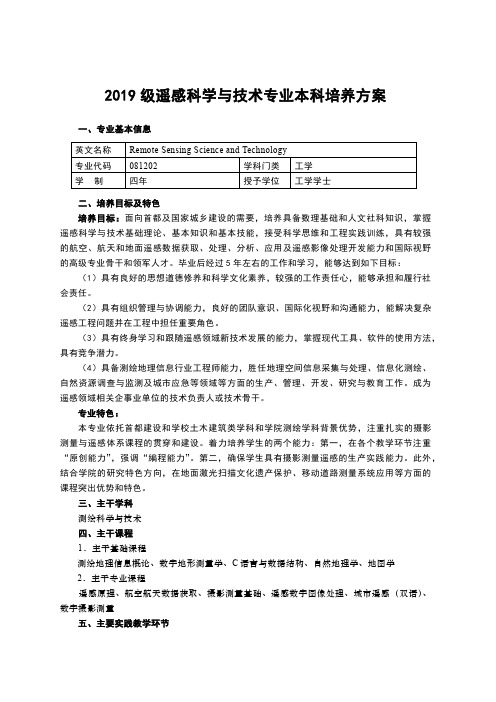
2019级遥感科学与技术专业本科培养方案一、专业基本信息二、培养目标及特色培养目标:面向首都及国家城乡建设的需要,培养具备数理基础和人文社科知识,掌握遥感科学与技术基础理论、基本知识和基本技能,接受科学思维和工程实践训练,具有较强的航空、航天和地面遥感数据获取、处理、分析、应用及遥感影像处理开发能力和国际视野的高级专业骨干和领军人才。
毕业后经过5年左右的工作和学习,能够达到如下目标:(1)具有良好的思想道德修养和科学文化素养,较强的工作责任心,能够承担和履行社会责任。
(2)具有组织管理与协调能力,良好的团队意识、国际化视野和沟通能力,能解决复杂遥感工程问题并在工程中担任重要角色。
(3)具有终身学习和跟随遥感领域新技术发展的能力,掌握现代工具、软件的使用方法,具有竞争潜力。
(4)具备测绘地理信息行业工程师能力,胜任地理空间信息采集与处理、信息化测绘、自然资源调查与监测及城市应急等领域等方面的生产、管理、开发、研究与教育工作。
成为遥感领域相关企事业单位的技术负责人或技术骨干。
专业特色:本专业依托首都建设和学校土木建筑类学科和学院测绘学科背景优势,注重扎实的摄影测量与遥感体系课程的贯穿和建设。
着力培养学生的两个能力:第一,在各个教学环节注重“原创能力”,强调“编程能力”。
第二,确保学生具有摄影测量遥感的生产实践能力。
此外,结合学院的研究特色方向,在地面激光扫描文化遗产保护、移动道路测量系统应用等方面的课程突出优势和特色。
三、主干学科测绘科学与技术四、主干课程1.主干基础课程测绘地理信息概论、数字地形测量学、C语言与数据结构、自然地理学、地图学2.主干专业课程遥感原理、航空航天数据获取、摄影测量基础、遥感数字图像处理、城市遥感(双语)、数字摄影测量五、主要实践教学环节数字地形测量学实习、摄影测量基础实习、航空数据获取实习、遥感原理实习、遥感数字图像处理、遥感综合实习、自然地理地貌及遥感图像解译实习、(近景与激光雷达、移动测量、微波遥感)新技术综合实习、地理信息系统原理实习、空间信息综合实习、毕业设计。
遥感科学与技术专业培养方案
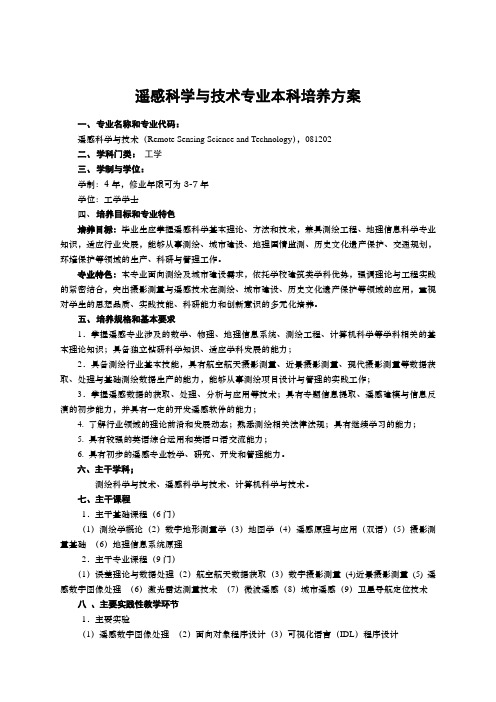
遥感科学与技术专业本科培养方案一、专业名称和专业代码:遥感科学与技术(Remote Sensing Science and Technology),081202二、学科门类:工学三、学制与学位:学制:4年,修业年限可为3-7年学位:工学学士四、培养目标和专业特色培养目标:毕业生应掌握遥感科学基本理论、方法和技术,兼具测绘工程、地理信息科学专业知识,适应行业发展,能够从事测绘、城市建设、地理国情监测、历史文化遗产保护、交通规划,环境保护等领域的生产、科研与管理工作。
专业特色:本专业面向测绘及城市建设需求,依托学校建筑类学科优势,强调理论与工程实践的紧密结合,突出摄影测量与遥感技术在测绘、城市建设、历史文化遗产保护等领域的应用,重视对学生的思想品质、实践技能、科研能力和创新意识的多元化培养。
五、培养规格和基本要求1.掌握遥感专业涉及的数学、物理、地理信息系统、测绘工程、计算机科学等学科相关的基本理论知识;具备独立钻研科学知识、适应学科发展的能力;2.具备测绘行业基本技能,具有航空航天摄影测量、近景摄影测量、现代摄影测量等数据获取、处理与基础测绘数据生产的能力,能够从事测绘项目设计与管理的实践工作;3.掌握遥感数据的获取、处理、分析与应用等技术;具有专题信息提取、遥感建模与信息反演的初步能力,并具有一定的开发遥感软件的能力;4. 了解行业领域的理论前沿和发展动态;熟悉测绘相关法律法规;具有继续学习的能力;5. 具有较强的英语综合运用和英语口语交流能力;6. 具有初步的遥感专业教学、研究、开发和管理能力。
六、主干学科;测绘科学与技术、遥感科学与技术、计算机科学与技术。
七、主干课程1.主干基础课程(6门)(1)测绘学概论(2)数字地形测量学(3)地图学(4)遥感原理与应用(双语)(5)摄影测量基础(6)地理信息系统原理2.主干专业课程(9门)(1)误差理论与数据处理(2)航空航天数据获取(3)数字摄影测量(4)近景摄影测量(5) 遥感数字图像处理(6)激光雷达测量技术(7)微波遥感(8)城市遥感(9)卫星导航定位技术八、主要实践性教学环节1.主要实验(1)遥感数字图像处理(2)面向对象程序设计(3)可视化语言(IDL)程序设计2.主要实践环节(1)数字地形测量学实习(2)地图学实习(3)地理信息系统原理实习(4)遥感原理与应用实习(5)面向对象程序设计实习(6)数字摄影测量实习(7)近景摄影测量实习(8)遥感图像解译实习(9)遥感数字图像处理实习(10)微波遥感实习(11)摄影测量基础实习(12)卫星导航定位技术实习(13)可视化语言(IDL)程序设计实习(14)综合实习(15)毕业设计九、毕业合格标准本专业要求的毕业最低总学分为172学分,且每学期最低修读17学分。
武汉大学遥感信息工程学院本科培养方案

0801336 地籍测量
2
数学规划在测量中的
0800670 应用
2
0700453 数学建模
2
36 36 36 36 36 36
1300037 1300357 1300358 1300200 1300359 1300360 1300356 1300362 1300363 1300364 1300365 1300366 1300367 1300369 1300368 1300366 1300371 1300372 1300371 1300373 1300400
四、学制和学分要求
学制:4 年。 学分:150 分。
五、学位授予
授予工学学士学位。
六、专业主干(核心)课程
学科基础(平台)课程: 测绘学概论、遥感原理与应用、地理信息系统原理、GPS 原理及其应用、数字图像处 理、测量学 其他主干课程: 遥感物理基础,遥感图像解译,遥感应用模型,摄影测量基础,数字摄影测量,近景摄 影测量,空间数据库,空间分析与应用,GIS 工程技术
遥感信息工程学院现设有空间信息工程系、摄影测量与遥感系和实验中心。 空间信息工程系下设地理信息系统教研室。 摄影测量与遥感系下设摄影测量教研室、遥感教研室。 实验中心下设摄影测量实验室、遥感实验室和地理信息系统实验室。 学院设置的本科专业有:遥感科学与技术专业。专业方向包括:遥感信息工程、摄影测 量、地理信息工程。 设置的其他本、专科专业:信息工程(成人教育)、信息技术应用(成人教育)。
修 学类至少修满 4 学分。学生选修与本专业重复或相近的课程,不计入通识教育学分。跨领域的课程修习
均承认学分。)
专 业
0700004 高等数学 A
1 2
216
21 6
武汉大学测绘学院遥感学院本科生培养方案

测绘学院School of Geodesy and Geomatics测绘学院是我国测绘教育事业的著名学府,源于1956年的武汉测量制图学院,她以当时的同济大学、天津大学、南京工学院、华南工学院、青岛工学院等几所高校测绘专业的师资和设备为基础组建,隶属国家教育部,并于1958年划归国家测绘局管理,易名为武汉测绘学院;1978年,武汉测绘学院被批准为全国重点大学,1980年成为国务院批准的首批具有硕士、博士学位授予权的单位之一,1985年10月,学校更名为武汉测绘科技大学,1993年12月,武汉测绘科技大学原大地测量系与工程测量系合并组建了地学测量工程学院,2000年8月,在国家教育部的支持下,武汉测绘科技大学与当时的武汉大学、武汉水利电力大学、湖北医科大学合并,成立了新的武汉大学。
在新的武汉大学建制下,在原武汉测绘科技大学地学测量工程学院的基础上组建了武汉大学测绘学院。
学院下设测量工程系、卫星应用工程系、地球物理系,是全国高等学校测绘学科教学指导委员会主任单位,现有测绘工程和地球物理两个本科专业,具有测绘科学与技术一级学科博士点、地球物理学一级学科博士点,并设有博士后科研流动站。
学院现有大地测量与测量工程(国家重点学科)硕士及博士授权点、固体地球物理学(省重点学科)硕士及博士授权点。
学院拥有三个部级重点实验室:地球空间环境与大地测量教育部重点实验室、精密工程测量与测量机器人国家测绘局重点实验室、极地测绘科学国家测绘局重点实验室,以及武汉大学灾害监测与防治研究中心、国际全球导航卫星服务系统(IGS)永久性卫星跟踪站、GPS 差分基准站等,学院教学、科研设备齐全,有充足的高端GPS接收机、各种类型的全站仪、三维激光扫描仪、数字水准仪、影像处理软硬件、地球物理实验仪器等。
学院内设五个研究所:航天航空测绘研究所、空间信息工程研究所、测量工程研究所、地球物理大地测量研究所、卫星应用工程研究所,设有为本科教学服务的测绘实验中心、地球物理实验室和多个为科研服务的专业实验室。
遥感科学与技术专业本科人才培养方案 (2010年版)_图文
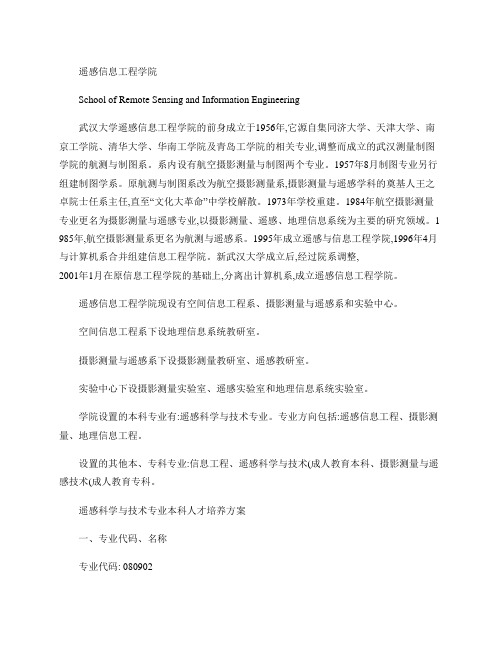
遥感信息工程学院School of Remote Sensing and Information Engineering武汉大学遥感信息工程学院的前身成立于1956年,它源自集同济大学、天津大学、南京工学院、清华大学、华南工学院及青岛工学院的相关专业,调整而成立的武汉测量制图学院的航测与制图系。
系内设有航空摄影测量与制图两个专业。
1957年8月制图专业另行组建制图学系。
原航测与制图系改为航空摄影测量系,摄影测量与遥感学科的奠基人王之卓院士任系主任,直至“文化大革命”中学校解散。
1973年学校重建。
1984年航空摄影测量专业更名为摄影测量与遥感专业,以摄影测量、遥感、地理信息系统为主要的研究领域。
1 985年,航空摄影测量系更名为航测与遥感系。
1995年成立遥感与信息工程学院,1996年4月与计算机系合并组建信息工程学院。
新武汉大学成立后,经过院系调整,2001年1月在原信息工程学院的基础上,分离出计算机系,成立遥感信息工程学院。
遥感信息工程学院现设有空间信息工程系、摄影测量与遥感系和实验中心。
空间信息工程系下设地理信息系统教研室。
摄影测量与遥感系下设摄影测量教研室、遥感教研室。
实验中心下设摄影测量实验室、遥感实验室和地理信息系统实验室。
学院设置的本科专业有:遥感科学与技术专业。
专业方向包括:遥感信息工程、摄影测量、地理信息工程。
设置的其他本、专科专业:信息工程、遥感科学与技术(成人教育本科、摄影测量与遥感技术(成人教育专科。
遥感科学与技术专业本科人才培养方案一、专业代码、名称专业代码: 080902专业名称:遥感科学与技术专业(Remote Sensing Science and Technology二、专业培养目标本专业面向国家空间信息基础设施建设的需要,培养掌握遥感科学基本理论、方法和技术,具有空间信息获取、处理、分析和应用专业知识的复合型高级技术应用人才。
三、专业特色和培养要求遥感科学与技术是在空间科学、信息科学、地球科学、电子科学、计算机科学与其它学科交叉渗透、相互融合的基础上发展起来的一门新型、边缘学科。
遥感科学与技术专业本科培养方案
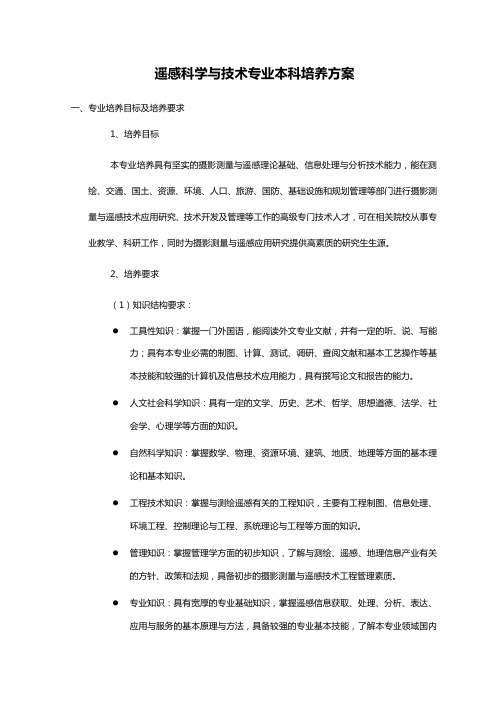
遥感科学与技术专业本科培养方案一、专业培养目标及培养要求1、培养目标本专业培养具有坚实的摄影测量与遥感理论基础、信息处理与分析技术能力,能在测绘、交通、国土、资源、环境、人口、旅游、国防、基础设施和规划管理等部门进行摄影测量与遥感技术应用研究、技术开发及管理等工作的高级专门技术人才,可在相关院校从事专业教学、科研工作,同时为摄影测量与遥感应用研究提供高素质的研究生生源。
2、培养要求(1)知识结构要求:工具性知识:掌握一门外国语,能阅读外文专业文献,并有一定的听、说、写能力;具有本专业必需的制图、计算、测试、调研、查阅文献和基本工艺操作等基本技能和较强的计算机及信息技术应用能力,具有撰写论文和报告的能力。
人文社会科学知识:具有一定的文学、历史、艺术、哲学、思想道德、法学、社会学、心理学等方面的知识。
自然科学知识:掌握数学、物理、资源环境、建筑、地质、地理等方面的基本理论和基本知识。
工程技术知识:掌握与测绘遥感有关的工程知识,主要有工程制图、信息处理、环境工程、控制理论与工程、系统理论与工程等方面的知识。
管理知识:掌握管理学方面的初步知识,了解与测绘、遥感、地理信息产业有关的方针、政策和法规,具备初步的摄影测量与遥感技术工程管理素质。
专业知识:具有宽厚的专业基础知识,掌握遥感信息获取、处理、分析、表达、应用与服务的基本原理与方法,具备较强的专业基本技能,了解本专业领域国内外最新技术现状和发展趋势。
(2)能力结构要求:获取知识能力:具有自主学习和自我发展的能力,能够开展学术交流和社会交际。
应用知识能力:具有综合运用所掌握的专业理论知识和技能,能够解决测绘遥感工程技术及相关工程领域实际问题。
创新研究能力:具有较强的创新思维,能够开展创新实验和创新科技开发与研究。
(3)素质结构要求:思想道德素质:品质高尚、人格完善,具有较强的团队意识和合作精神,较强的敬业精神和吃苦精神,能够和社会融洽相处,正确处理好个人与社会的关系。
遥感培养计划

3 64 50 14
4☆
geodesy
数据结构 Data structure
2 48 36 12
3☆
数字测图原理与方
法
The principle and 3 60 50 10
4☆
method of digital
mapping
GPS原理与应用
The principle and 3 50 40 10
3☆
5 2.77
院定 选修 课学 分
1 24
7 3.88
实践 环节 学分
2
32
5
7
17
36
20. 00
创新 活动 学分
4 2.22
学
分 合
22 26.5 22.5 26 19.5 18.5 24 17 180
100
计
九、各教学环节安排及时间分配
理论教学:104周,其中:第一学期15周,第二学期18周, 第三学期16周,第四学期15周,第五学期16周,第六学期13 周,第七学期11周。
实践教学:1、地球科学概论实习,2周,在第三学期进行。 2、数字测图实习,3周,在第四学期进行,学习测绘仪器的 使用和基本测量方法。 3、大地测量学基础实习,3周,在第六学期进行。 4、遥感图像解译实习,2周,在第六学期进行,典型地物解 译与野外验证、地物波谱测试与分析。 5、软件工程课程设计,2周,在第七学期进行,每人设计一 个小型的软件系统。
四、主要实践性教学环节:
包括专业基础课实验、实习、毕业设计(论文)等,安排29 周,详见培养计划一览表。
五、修业年限 :四年。
六、授予学位:工学学士。
七、相近专业:地图制图与地理信息工程、大地测量与
遥感科学与技术专业培养计划
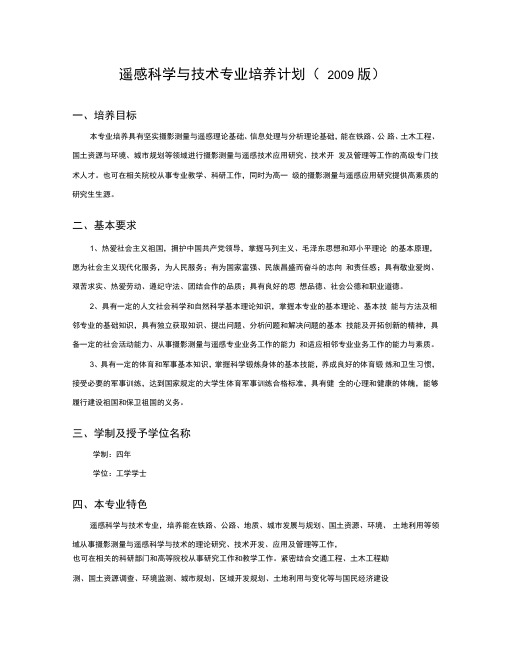
遥感科学与技术专业培养计划(2009 版)一、培养目标本专业培养具有坚实摄影测量与遥感理论基础、信息处理与分析理论基础,能在铁路、公路、土木工程、国土资源与环境、城市规划等领域进行摄影测量与遥感技术应用研究、技术开发及管理等工作的高级专门技术人才。
也可在相关院校从事专业教学、科研工作,同时为高一级的摄影测量与遥感应用研究提供高素质的研究生生源。
二、基本要求1、热爱社会主义祖国,拥护中国共产党领导,掌握马列主义、毛泽东思想和邓小平理论的基本原理,愿为社会主义现代化服务,为人民服务;有为国家富强、民族昌盛而奋斗的志向和责任感;具有敬业爱岗、艰苦求实、热爱劳动、遵纪守法、团结合作的品质;具有良好的思想品德、社会公德和职业道德。
2、具有一定的人文社会科学和自然科学基本理论知识,掌握本专业的基本理论、基本技能与方法及相邻专业的基础知识,具有独立获取知识、提出问题、分析问题和解决问题的基本技能及开拓创新的精神,具备一定的社会活动能力、从事摄影测量与遥感专业业务工作的能力和适应相邻专业业务工作的能力与素质。
3、具有一定的体育和军事基本知识,掌握科学锻炼身体的基本技能,养成良好的体育锻炼和卫生习惯,接受必要的军事训练,达到国家规定的大学生体育军事训练合格标准,具有健全的心理和健康的体魄,能够履行建设祖国和保卫祖国的义务。
三、学制及授予学位名称学制:四年学位:工学学士四、本专业特色遥感科学与技术专业,培养能在铁路、公路、地质、城市发展与规划、国土资源、环境、土地利用等领域从事摄影测量与遥感科学与技术的理论研究、技术开发、应用及管理等工作,也可在相关的科研部门和高等院校从事研究工作和教学工作。
紧密结合交通工程、土木工程勘测、国土资源调查、环境监测、城市规划、区域开发规划、土地利用与变化等与国民经济建设和人民生活密切相关领域的实际应用,并顾及21世纪空间信息产业的发展新趋势,培养有较宽的基础理论和较强的动手能力,能适应空间信息产业发展的复合型工程技术人才。
遥感科学与技术培养方案遥感

专业选修课
遥感应用类基础课程:高分辨率卫星遥感、、测量平差,作为遥
感原理与应用课程的延伸 专业能力训练类课程:遥感解译与制图、遥感科学专业 文献阅读、科技写作 行业应用类课程:地质遥感、国土资源遥感
中国地质大学(武汉)信息工程学院
专业选修课
开设空间分析、软件过程与管理、空间数据结构、统计模
中国地质大学(武汉)信息工程学院
遥感科学与技术专业教学培养方案
专业培养目标
具有综合运用遥感、信息技术从事遥感相关领域科学研 究和工程开发能力的专业高级技术人才。
具备理工科的数理基础、计算机的软硬件知识、遥感专 业知识以及相关地学知识;掌握基于遥感影像的空间信 息采集、分析和应用的技术体系与方法。
中国地质大学(武汉)信息工程学院
式识别、数字信号分析、影像库技术等课程。
空间分析、空间数据结构培养学生掌握空间信息技术相 关关键技术方法,是地理信息系统原理课程的延伸。 数字信号分析、统计模式识别、影像库技术课程是指导 学生对遥感信息工程实施中关键技术进行进一步学习。 软件过程与管理课程让学生了解软件类产品开发的过程 管理方法,为从事遥感软件开发与管理打下基础。
掌握遥感常用专业设备与软件的使用以及开发。
中国地质大学(武汉)信息工程学院
遥感科学与技术专业课程体系
学科基础课、专业主干课和专业选修课三个课程群,加 上通识教育课程
计算机知识的课程设计、专业教学实习及毕业实习与毕 业设计(论文)
中国地质大学(武汉)信息工程学院
遥感科学与技术专业课程体系
中国地质大学(武汉)信息工程学院
专业主干课
第一层次是针对空间信息科学中的共性基础性问题,包括
遥感原理与应用、地理信息系统原理、地图学A
遥感科学与技术专业

遥感科学与技术专业培养方案一、培养目标本专业注重培养具备遥感科学与技术专业基础理论、基本知识和基本技能;能从事遥感科学与技术及相关领域的研究、开发、设计、教学、生产及管理等方面的工作,具有较强实际工程能力和一定研究能力的复合应用型人才。
二、培养要求本专业学生主要学习摄影测量与遥感以及相关一级学科下的空间定位、地图编制、地理信息系统等方面的基本理论,掌握遥感影像获取、信息处理、解译与分析的基本原理与技能,及从影像上提取空间属性信息的方法。
毕业生应获得以下几个方面的基本知识和能力:1.掌握数学、物理、电子技术、计算机科学等方面的基本理论和基本知识;2.掌握测量学、误差理论、数字图像处理、地理信息系统、地图学等本专业的基础理论与知识,了解相关专业知识;3. 掌握摄影测量与遥感技术的基本理论、知识和方法;初步具有摄影测量与遥感工程的设计、作业、生产、研究、开发与组织管理和遥感图像信息处理、分析、解译、运用能力。
4.了解遥感科学与技术的理论前沿、应用前景和最新发展动态;了解摄影测量与遥感产业发展状况。
5.了解国家科学技术政策、知识产权、可持续发展战略等有关政策和法规;6. 具有运用专业基本理论和方法发现、分析、处理实际问题的能力;具有求异思维和探索精神。
7.掌握资料查询、文献检索的基本方法;具有一定的实验设计、创造实验条件,归纳、整理、分析实验结果,和撰写学术论文的能力。
三、主干学科、主要课程、课程平台及学分比例1、主干学科遥感科学与技术专业的主干学科是测绘科学与技术一级学科下的摄影测量与遥感二级学科。
2、主要课程遥感科学与技术专业的主要课程包括:测量学基础、数字测图原理与方法、地图学、测量平差基础、大地测量学、航空与航天摄影、摄影测量学、数字摄影测量学、数字图像处理、遥感原理与应用、GPS原理与应用、GIS原理与应用、遥感图像解译。
3、课程平台及学分比例四、修业年限、毕业学分要求与授予学位1. 修业年限:3-6年2.毕业学分要求:总学分182.5学分3. 授予学位:工学学士五、就业(发展)方向毕业生可在测绘、遥感、地质、水利、交通、农业、林业、石油、矿山、煤炭、国防、军工、城建、环保、文物保护等行业和部门从事与摄影测量与遥感相关的科研、教学、设计、生产及管理工作。
- 1、下载文档前请自行甄别文档内容的完整性,平台不提供额外的编辑、内容补充、找答案等附加服务。
- 2、"仅部分预览"的文档,不可在线预览部分如存在完整性等问题,可反馈申请退款(可完整预览的文档不适用该条件!)。
- 3、如文档侵犯您的权益,请联系客服反馈,我们会尽快为您处理(人工客服工作时间:9:00-18:30)。
2016遥感科学与技术专业本科培养方案
一、专业基本信息
二、培养目标及特色(300字以内)
培养目标:
培养具有德、智、体全面发展,具备数理基础和人文社科知识,掌握遥感科学与技术基础理论、基本知识和基本技能,接受科学思维和工程实践训练,胜任国家基础测绘、城乡建设、国土资源、城市应急等领域空间信息的获取、处理、分析、应用及管理工作,具有较强的组织管理能力、创新能力、继续学习能力和国际视野的复合型工程技术人才。
专业特色:
本专业依托首都建设和学校土木建筑类学科优势,培养服务首都、面向全国、依托建筑行业、服务城乡建设的专业人才。
适应摄影测量与遥感高新科技发展,融教学、科研和生产为一体,强调理论与实践密切结合,突出城市遥感特色,培养摄影测量与遥感新技术、新方法、新工艺的应用能力,满足城乡建设、古建筑保护、智慧城市等遥感人才需求。
三、主干学科
测绘科学与技术
四、主干课程
1.主干基础课程
专业概论、数字地形测量学、C语言与数据结构、自然地理学、地图学
2.主干专业课程
遥感原理(双语)、航空航天数据获取、摄影测量基础、遥感数字图像处理、城市遥感、数字摄影测量
五、主要实践教学环节
数字地形测量学实习、摄影测量基础实习、航空数据获取、航空摄影测量外业综合实习、4D产品综合摄影测量实习、遥感原理实习、遥感数字图像处理、遥感综合实习、自然地理地貌及遥感图像解译实习、(近景与激光雷达、移动测量、微波遥感)新技术综合实习、地理信息系统原理、毕业设计。
六、毕业学分要求
参照北京建筑大学本科学生学业修读管理规定及学士学位授予细则,修满本专业最低计划学分应达到160学分,其中理论课程122学分,实践教学环节38学分。
七、各类课程结构比例
学分比例学时学分课程属性课程类别
九、毕业生应具备的知识能力及实现矩阵
十、指导性教学计划(见附表)
十一、主要课程逻辑关系结构图(见最后)
2016 Undergraduate Program for Specialty in Remote Sensing Science and Techolonogy
Educational Objectives
、II :Oriented by the country and capital urban and rural construction, the Educational Objectives aviation and aerospace remote sensing objective of education is to training the students to master the
analysis, processing, methods theory, and techniques, with spatial information acquisition,
and compound Students should be Multi-disciplinary talents on surveying application ability. mapping and imagery information processing.the relying on and urban construction , mapping Specialty: Demanding by surveying and
advantages of School of architecture discipline, we highlight the aspects of long-term accumulation
of theory and equipment advantages in photogrammetry and remote sensing of our school in the field the and refined urban management heritage of terrestrial lidar for ancient architectural protection, original attention to each city, smart In the cultivation of students' ability, in teaching link pay
the ensure ability. On the other hand, to that students have emphasize ability, programming production capacity of photogrammetry remote sensing.
、Major Disciplines III computer information mapping, geographic science, Surveying Science and technology of and
science and technology.
Major Courses IV、1 main basic courses
structure, digital Professional introduction, topographic surveying, C and data language geography, cartography
2 main courses
remote (Bilingual), sensing Remote principle aerospace acquisition, photogrammetry, data
sensing digital image processing, urban remote sensing, digital photogrammetry
Major Practical Training
、V.
Digital topographic survey practice, basic photogrammetry practice, aviation data acquisition,
field work practice of aerial photogrammetry control and annotation, 4D products integrated photogrammetric practice, practice of basic remote sensing, remote sensing digital image processing, remote sensing comprehensive practice, natural geography and remote sensing image interpretation practice, (close range and laser radar, mobile measurement, microwave remote sensing technology comprehensive practice, the principle of geographic information system, graduation design.
VI、Graduation Requirements
According to Beijing University of civil engineering and architecture undergraduate students studying management regulations and bachelor's degree granting rules, completed the professional plan minimum credits should reach 160 credits, the theoretical course of 115 credits, practice course of 45 credits.
VII、Proportion of Course
VIII、Table of Teaching Program
Table of Teaching Arrangement IX、
X、Graduate Abilities and Matrices。
